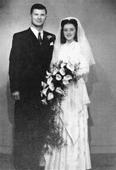 The wedding dress that was cleaned and restored by a Shanghai laundry company. (WANG XIANG /XINHUA)
The wedding dress that was cleaned and restored by a Shanghai laundry company. (WANG XIANG /XINHUA)
A wedding dress made with rare French satin and lace and embroidered with exquisite lily patterns has been restored and returned to the Shanghai Jewish Refugees Museum this month by a local laundry company.
The dress previously belonged to Betty Grebenschikoff, who now lives in Florida, United States.
Chen Jian, director of the museum, said Grebenschikoff took refuge in Shanghai after fleeing Germany with her parents in 1939 when she was 9 years old. She wore the wedding dress when she married her Russian husband at the Shanghai Park Hotel in 1948.
"The wedding dress witnessed a happy time for Jewish refugees in that difficult period, and also reflects the unique role played by Shanghai in helping Jewish refugees to survive and develop," Chen said.
Shanghai's Hongkou district was home to a Jewish community as early as the late 19th century. During World War II, more than 20,000 European Jews sought refuge in Shanghai and lived in the area. In 2008, Hongkou district restored the Moishe Synagogue and turned it into a memorial museum.
 Betty Grebenschikoff and her husband pose for their wedding photo in 1948 in Shanghai. (PHOTO PROVIDED TO CHINA DAILY)
Betty Grebenschikoff and her husband pose for their wedding photo in 1948 in Shanghai. (PHOTO PROVIDED TO CHINA DAILY)
Chen said the wedding dress was sewn by Grebenschikoff's mother-in-law. Two of Grebenschikoff's three daughters married in the same dress, which she took with her when she left Shanghai in 1950.
In 2013, Grebenschikoff visited Shanghai with one of her daughters and decided to donate the dress during a visit to the museum.
Cao Liping, manager of Shanghai Elephant King Laundry, said she had mixed feelings when she saw the wedding dress because she knew restoring it would be a very complicated task. All the fabric was oxidized with very serious stains and mildew, and the silk at the bottom was also damaged.
"Some other organizations that deal with cultural relics had no way to restore the dress and were afraid of damaging it, so I thought we had a responsibility and obligation to repair the dress and had to accept the challenge," she said.
Cao said removing large areas of old stains was the most difficult task.
"We chose manual operation instead of using machines to remove stains since the high temperature might cause damage to the aging fabrics," she said. "The cleaning liquid was also remixed so that the acid and alkali were relatively neutralized to soak and remove stains."
The moldy spots were also treated specially, and the worn parts then repaired. It took four workers three days to complete the cleaning and repairs, she said.
"I haven't faced such a challenge for at least 10 years in my 22-year career," Cao said. "The museum told me not to make any mistakes, I'm very proud of the fact that our work has finally brought this cultural relic back to life."
Grebenschikoff, who viewed a video of her restored wedding dress, was "more than happy", Chen said.


